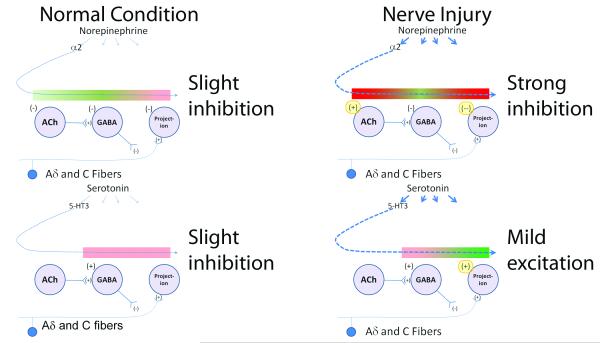Figure 7.
Net effect of α2-adrenoceptor and 5-hydroxytryptamine-3 (5-HT3) receptors on nociceptive sensory transmission in the spinal cord of normal (left) and nerve injured (right) animals. The colored bar indicates the effect of each step in the proposed circuit of these neurotransmitters, with green depicting increased nociceptive neurotransmission and red depicting reduced nociceptive neurotransmission. Both norepinephrine and serotonin are released from pathways which descend to the spinal cord, and act on many receptor subtypes.
As regards α2-adrenoceptors, norepinephrine release is minimal in the normal condition, and it’s net effect is slight inhibition, due to and actions on primary afferent endings and projection neurons (upper left panel). This effect is only mildly counterbalanced by inhibition of acetylcholine (ACh) release which would drive γ-amino benzoic acid (GABA) release and by direct inhibition of GABA release. After nerve injury, norepinephrine release increases and the effect of α2-adrenoceptors on ACh shifts from inhibition to excitation and the expression of inhibitory α2-adrenoceptors on afferents and projection neurons increases (highlighted in yellow), resulting in strong inhibition (upper right panel).
As regards 5-HT3 receptors, serotonin release is minimal in the normal condition, and it’s net effect is slight inhibition, due to direct stimulation of GABA release (lower left panel). After nerve injury, serotonin release increases and the effect of 5-HT3 receptors results in enhanced nociception neurotransmission, due to increased excitatory signaling on afferents and projection neurons (highlighted in yellow, lower right panel).

